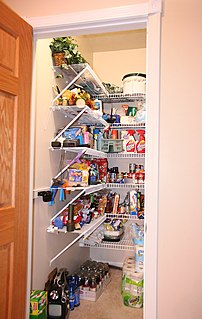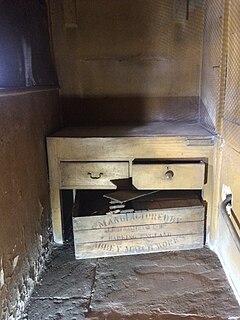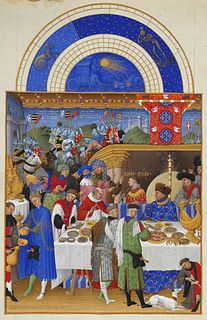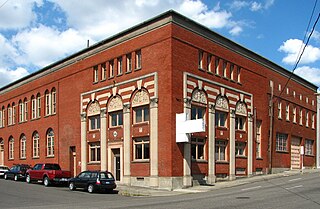
A closet is an enclosed space, with a door, used for storage, particularly that of clothes. Fitted closets are built into the walls of the house so that they take up no apparent space in the room. Closets are often built under stairs, thereby using awkward space that would otherwise go unused.

Homemaking is mainly an American and Canadian term for the management of a home, otherwise known as housework, housekeeping, housewifery or household management. It is the act of overseeing the organizational, day-to-day operations of a house or estate, and the managing of other domestic concerns. A person in charge of the homemaking, who is not employed outside the home, in the US and Canada is called a homemaker, a term for a housewife or a househusband. Historically the role of homemaker was often assumed by women. The term "Suzy Homemaker" was used to refer to women who naturally took on the responsibilities of managing the household. The responsibilities of a "Suzy Homemaker" primarily consisted of performing household duties and childrearing. The term "homemaker", however, may also refer to a social worker who manages a household during the incapacity of the housewife or househusband. Home health workers resume the role of homemakers when caring for elderly individuals. This includes preparing meals, giving baths, and any duties the person in need cannot perform for themselves.

Hygiene is a series of practices performed to preserve health. According to the World Health Organization (WHO), "Hygiene refers to conditions and practices that help to maintain health and prevent the spread of diseases." Personal hygiene refers to maintaining the body's cleanliness. Hygiene activities can be grouped into the following: home and everyday hygiene, personal hygiene, medical hygiene, sleep hygiene and food hygiene. Home and every day hygiene includes hand washing, respiratory hygiene, food hygiene at home, hygiene in the kitchen, hygiene in the bathroom, laundry hygiene and medical hygiene at home.

A towel is a piece of absorbent cloth or paper used for drying or wiping a surface. Towels draw moisture through direct contact.

A home appliance, also referred to as a domestic appliance, an electric appliance or a household appliance, is a machine which assists in household functions such as cooking, cleaning and food preservation.

A pantry is a room or cupboard where beverages, food, and sometimes dishes, household cleaning products, linens, or provisions are stored. Food and beverage pantries serve in an ancillary capacity to the kitchen.

A sacristy, also known as a vestry or preparation room, is a room in Christian churches for the keeping of vestments and other church furnishings, sacred vessels, and parish records.

A mangle or wringer is a mechanical laundry aid consisting of two rollers in a sturdy frame, connected by cogs and powered by a hand crank or by electricity. While the appliance was originally used to wring water from wet laundry, today mangles are used to press or flatten sheets, tablecloths, kitchen towels, or clothing and other laundry.

A chest is a form of furniture typically of a rectangular structure with four walls and a removable or hinged lid, used for storage, usually of personal items. The interior space may be subdivided.
Housekeeping refers to the management of duties and chores involved in the running of a household, such as cleaning, cooking, home maintenance, shopping, and bill payment. These tasks may be performed by members of the household, or by other persons hired for the purpose. This is a more broad role than a cleaner, who is focussed only on the cleaning aspect. The term is also used to refer to the money allocated for such use. By extension, it may also refer to an office or organization, as well as the maintenance of computer storage systems.

A larder is a cool area for storing food prior to use. Originally, it was where raw meat was larded—covered in fat—to be preserved. By the 18th century, the term had expanded. Now a dry larder was where bread, pastry, milk, butter, or cooked meats were stored. Larders were commonplace in houses before the widespread use of the refrigerator.

A cupboard is a piece of furniture for enclosing dishware or grocery items that are stored in a home. The term gradually evolved from its original meaning: an open-shelved side table for displaying dishware, more specifically plates, cups and saucers. These open cupboards typically had between one and three display tiers, and at the time, a drawer or multiple drawers fitted to them.
Linens are fabric household goods intended for daily use, such as bedding, tablecloths and towels. "Linens" may also refer to church linens, meaning the altar cloths used in church.
A ewery was the office in a wealthy medieval English household responsible for water and the vessels for drinking or washing of the person. The word derives from "ewer", a type of pitcher. This office was not responsible for laundry, which was handled by the offices of laundry and napery. The three offices did work closely together, however, and could be concurrent in smaller households.

In a building or large vehicle, like a ship, a room is any space enclosed within a number of walls to which entry is possible only by a door or other dividing structure that connects it either to a passageway, to another room, or to the outdoors, that is large enough for several people to move about, and whose size, fixtures, furnishings, and sometimes placement within the building or ship support the activity to be conducted in it.

The medieval household was, like modern households, the center of family life for all classes of European society. Yet in contrast to the household of today, it consisted of many more individuals than the nuclear family. From the household of the king to the humblest peasant dwelling, more or less distant relatives and varying numbers of servants and dependents would cohabit with the master of the house and his immediate family. The structure of the medieval household was largely dissolved by the advent of privacy in early modern Europe.
Thomas Ferguson Irish Linen is the last remaining of the old established Irish linen Jacquard weavers in Ireland. Situated in Banbridge, Northern Ireland it has been weaving since 1854. The Company, bears the name of its founder, Thomas Ferguson (1820–1900), who was born at Clare, near the village of Waringstown in Co. Down.

The Yale Union Laundry Building, also known as the Yale Laundry Building, the City Linen Supply Co. Building, Perfect Fit Manufacturing and simply Yale Union (YU), in southeast Portland, Oregon, is a two-story commercial structure listed on the National Register of Historic Places. Built largely of brick in 1908, and embellished with Italian Revival and Egyptian Revival decorations, it was added to the register in 2007. Two-story additions in 1927 and 1929 changed the original building into an L-shaped structure that shares a party wall with a building to the east.

One of the earliest documented uses of Yeoman, it refers to a servant or attendant in a late Medieval English royal or noble household. A Yeoman was usually of higher rank in the household hierarchy. This hierarchy reflected the feudal society in which they lived. Everyone who served a royal or noble household knew their duties, and knew their place. This was especially important when the household staff consisted of both nobles and commoners. There were actually two household hierarchies which existed in parallel. One was the organization based upon the function (duty) being performed. The other was based upon whether the person performing the duty was a noble or a commoner.















